Across the world, museums, galleries, historic sites, art fairs, biennials, and auctions have closed. Livelihoods are at risk as a result of an unprecedented but essential move to protect our healthcare systems from the threat of Covid-19.
As the days and the news broadcasts begin to warp into a continuum of unfamiliar pressures and anxieties, these treasured homes of the arts and culture must innovate to survive in a sector that thrives on bringing people together to share experiences. Life as we know it is on pause until further notice, yet artistic and cultural bodies and heritage organisations have begun to draw on their seemingly limitless ingenuity to connect, comfort and uplift us as we face these uniquely challenging circumstances.
The very notion of culture is challenged by the current socio-political landscape of self-isolation and quarantine. So, how can we define and propagate culture, and immerse ourselves in it, in a state of lockdown?
It seems the pandemic has proven a necessary catalyst for a sector that needed to modernise. The art world is undergoing an overdue reinvention as galleries and museums invest in digital platforms to support their invaluable offering, and as projects developed in recent years fulfil their promise. Immersive exhibitions accessible from our own homes will redefine our collective interactions with artworks; podcasts with the world’s most well-known artists will leave us feeling closer to these revered figures than ever before. Arts organisations’ recent investments in social media and digital content are paving the way for a new art scene: a global community that will protect, educate and excite us in times of trouble and beyond. Here lies an opportunity for reinvention, and it has readily been taken up.
Our sustained engagement with culture and the arts is crucial throughout this crisis. Now is the time to fill our collective consciousness with the richness of what has been created, recorded, remembered and displayed. Under no circumstances should we let the arts and their diverse offering grind to a halt under the weight of this insidious pandemic. It is crucial to keep the arts alive in people’s homes.
I believe that engaging with the arts and culture, both at individual and societal levels, is increasingly important in the 21st century. As major political and global events become ever more unpredictable and the world we once knew recedes further into memory, the arts and culture provide a grounding force that is crucial to education, the economy and our sense of wellbeing. They help us to understand ourselves, and they improve children’s cognitive abilities: they are socially indispensable. In the UK, the arts and culture industry annually contributes more than £10 billion to the economy. Research from Arts Council England has provided evidence that a higher rate of engagement with arts and culture is generally associated with a higher level of subjective wellbeing in adults.
Moreover, nationwide participation in the sector can contribute to community bonding. Art can reinforce social inclusion and togetherness, making communities feel safer and more resilient. It is a force for good that we simply cannot go without.
As Sir Peter Bazalgette, former chair of Arts Council England, so eloquently puts it in his foreword in ‘The Value of Arts and Culture to People and Society’, a report published in 2014: ‘Life without the collective resources of our libraries, museums, theatres and galleries, or without the personal expression of literature, music and art, would be static and sterile.’
What does this societal remedy, this emotional backbone of our communities, look like in a state of quarantine?
Technology and Culture
They say necessity breeds innovation, and museums, art galleries and artists are doing just this; responding to the crisis and its paralysing effects in truly compelling ways in an effort to maintain global engagement.
This move to digitise the world’s access to, and experience of, great works of art, has its roots in a time before the pandemic. Google Arts & Culture, founded in 2011, is an online platform for public access to high-resolution images of many of the world’s greatest artworks, housed in the venture’s partner museums, including the Tate, the Metropolitan Museum of Art, New York, and the Uffizi in Florence. The imaging technology used by Google Arts & Culture enables visitors to the platform to immerse themselves fully in the artworks and corresponding literature with a ‘walk-through’ feature using Google’s Street View system.
However, in this state of quarantine, many other media and cultural platforms have put initiatives in place to protect the status of the arts in our lives. In March, the BBC announced the launch of an essential arts and culture service to, in the words of Jonty Claypole, director of BBC Arts, ‘give British culture an audience that can’t be there in person […] keep[ing] the arts alive in people’s homes’. This service will focus on content around the exhibitions and permanent collections at museums and galleries, live performances and digital book festivals, across the broadcaster’s TV, radio and digital catch-up platforms.
Swiss-owned Art Basel Hong Kong was the first major event to cancel its annual physical iteration, and instead took place online. Usually, the fair attracts close to 90,000 visitors across sprawling halls of exhibitors. Hong Kong’s art community has banded together to launch a new platform, ART Power HK, offering 60 of the city’s cultural sites, museums, galleries and auction houses the opportunity to continue showing art. The online platform includes online viewing rooms, live exhibition walk-throughs and an interactive programme of artist talks. Back in Europe, meanwhile, the Castello di Rivoli, Turin, has launched its ‘Digital Cosmos’ project, which includes works by leading contemporary artists which are designed for digital viewing; the museum’s director, Carolyn Christov-Bakargiev, has said that making the collection accessible at this time is a matter of ‘public duty’.
This progressive activity is not just the preserve of the larger museums and art galleries. Smaller sites of cultural interest and art businesses have been forced to close their doors to the public too, but are combatting this lapse in footfall with digital initiatives, including online exhibitions. For example, the London-based Guts Gallery hosted an Instagram-only exhibition on 26 March, during which all the works were shared simultaneously on the social media platform.
The initiatives of this kind are myriad, and it brings me great pleasure to know that so many people view the safeguarding of the arts and culture as paramount throughout these testing times. In many ways, this drive to the digital and to social media has galvanised our collective sense of belonging, of culture, as never before.
The impact of Covid-19 on the health of the art market in the long term is still unclear but I do not foresee the withdrawal of key investors as it migrates to digital platforms. Instead of attending fairs and auctions, of which all have been cancelled and where most major sales are traditionally made, buyers will look to the digital offering. This migration will drive an increase in the demand for e-commerce, and in turn, tighter online security measures, reassurance around provenance, and price transparency. This revolution in the trade will open up more opportunities for investment at auctions and art fairs that buyers may not have been able to attend, perhaps also eliminating some of the high overheads of galleries and auction houses in the long term.
The Nicole Brachetti Peretti Collection

Nicole Brachetti Peretti
It has been something of a personal mission over the last decade to garner support for culture and the arts through my own platforms, including the founding of the Nicole Brachetti Peretti Collection. I founded the collection in 2014 to unite artists and viewers under a common cause on the principle that contemporary art has the potential to catalyse a society defined by freedom of expression, intercultural dialogue, tolerance and peace.
That the arts are a driver for a sense of community is a central tenet of the collection. If you expand your view of the world through the arts, your sense of connection to other cultures, groups and schools of thought is reinforced. Ultimately, this can foster a global sense of community, displacing the divisions put in place by generations of illiberality, misinformation and inflexible politics. I feel a personal responsibility for curating art in a way that is not only aesthetically impactful but also tells a story about the world and its socio-political concerns in a sensitive, understanding and open way. If art forges connection, belonging and community, then both online and bricks-and-mortar galleries should be casting the net wide to forge a new interconnectedness.
There are two primary benefits to the way the arts and culture are manifesting themselves in this time of quarantine and physical restriction: accessibility and the instantaneousness of digital content. Shareable online programmes, images, recordings and beyond can reach a much larger audience more quickly than any physical gallery or museum.
Ultimately, culture in this time of quarantine is positive. It is present, engaging, dynamic, fresh and accessible, expressing itself in ways never previously explored. Artists, galleries, museums, songwriters, poets, writers and performers have banded together to conserve and protect the arts, understanding and revering their far-reaching benefits. Through these dark times, there exists an enduring summer: that community of creative people who have always enriched our lives and cultures across the world – and will continue to.
Unlimited access from just $16 every 3 months
Subscribe to get unlimited and exclusive access to the top art stories, interviews and exhibition reviews.














![Masterpiece [Re]discovery 2022. Photo: Ben Fisher Photography, courtesy of Masterpiece London](http://www.apollo-magazine.com/wp-content/uploads/2022/07/MPL2022_4263.jpg)
It’s time for the government of London to return to its rightful home